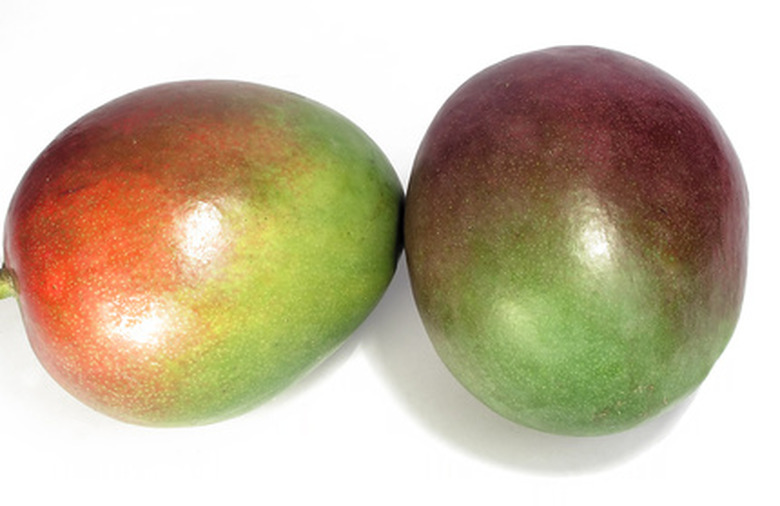How To Grow Mango Trees In Hawaii
Things Needed
- Spade
- Aged compost
- Fertilizer
- Mango seedling
- Water
Hawaii gardeners and homeowners prize the mango tree (Mangifera indica) for its glossy, dark green foliage and the profusion of 3 lb. fruit it produces every summer. It's also popular for being extremely hardy. The plant thrives in hot, dry areas of the Hawaiian islands and can even tolerate heavy clay soils. Start a mango tree in your backyard and enjoy a bountiful harvest of the brightly colored, yellow-fleshed fruit.
Step 1
Choose a sunny gardening area in which to plant the mango trees. Mangoes thrive in well-drained soil and will do best on a slightly sloping hill, according to the University of Hawaii, but can tolerate any kind of soil, including clay soil or sandy dirt.
- Hawaii gardeners and homeowners prize the mango tree (Mangifera indica) for its glossy, dark green foliage and the profusion of 3 lb.
- Mangoes thrive in well-drained soil and will do best on a slightly sloping hill, according to the University of Hawaii, but can tolerate any kind of soil, including clay soil or sandy dirt.
Step 2
Prepare the soil. For the best future fruit production, provide the tree with organic material-rich dirt, according to Purdue University. Stir in 6 to 10 inches of aged compost into the dirt.
Step 3
Dig a hole for the mango tree seedling. Make the hole twice as wide as the seedling's root ball or the diameter of its pot, and a couple of inches shorter than the pot or root ball. Keep the removed soil adjacent to the hole, as you'll be adding it back around the seedling later in the planting process.
Step 4
Add 2 tbsp. of 0-45-0 fertilizer into the bottom of the planting hole, mixing it thoroughly into the dirt. This will give the mango sapling a vitamin boost to help jump start its establishment.
- For the best future fruit production, provide the tree with organic material-rich dirt, according to Purdue University.
- of 0-45-0 fertilizer into the bottom of the planting hole, mixing it thoroughly into the dirt.
Step 5
Place the seedling into the hole. Pour soil around the sides of the seedling to fill in the hole. Water the area thoroughly to moisten the dirt to the depth of the sapling's root ball.
Step 6
Water the seedling once every two to three days until it is established, signified by the presence of new growth on the plant. Reduce watering after establishment, providing irrigation every two weeks during the tree's first year, according to the University of Hawaii. Watering is reduced even further in subsequent years. Water every three weeks in its second year, and once a month in its third year and all subsequent years.
- Place the seedling into the hole.
- Water the area thoroughly to moisten the dirt to the depth of the sapling's root ball.
Step 7
Fertilize the mango tree. The University of Hawaii recommends using a 10-20-20 fertilizer. Provide 2 lbs. of fertilizer to the tree in its first year and 3 lbs. annually in its second and third year. In all subsequent years, provide a pound of fertilizer for every inch of trunk diameter measured at a height of 4 feet from the ground. Split the total annual fertilizer amount into three evenly spaced applications.
- The University of Hawaii recommends using a 10-20-20 fertilizer.
- In all subsequent years, provide a pound of fertilizer for every inch of trunk diameter measured at a height of 4 feet from the ground.
Step 8
Harvest mangoes. It typically takes a mango seedling five years to begin bearing fruit, and they can produce fruit for more than four decades, according to the University of Hawaii. In Hawaii, mangoes are harvested from June through September. Fruit is ready for picking when it's orange, yellow or red in color.
Tip
The University of Hawaii recommends specific mango varieties for growing in Hawaii. These include the Rapoza, Fairchild, Momi K, Gouveia, Harders and Pope varieties.
Warning
In Hawaii, mangoes grow as tall as 90 feet and almost as large across. When choosing a location, gardeners should keep this mature size in mind. Don't plant your mango tree near utility lines or buildings, and remember that a tree of this size will cast a large shadow that may affect nearby vegetable plots or shrubs that need sun.
References
- "Growing Fruits in Hawaii"; Kathy Oshiro; 2000
- University of Hawaii: Mango
- Purdue University: Mango
